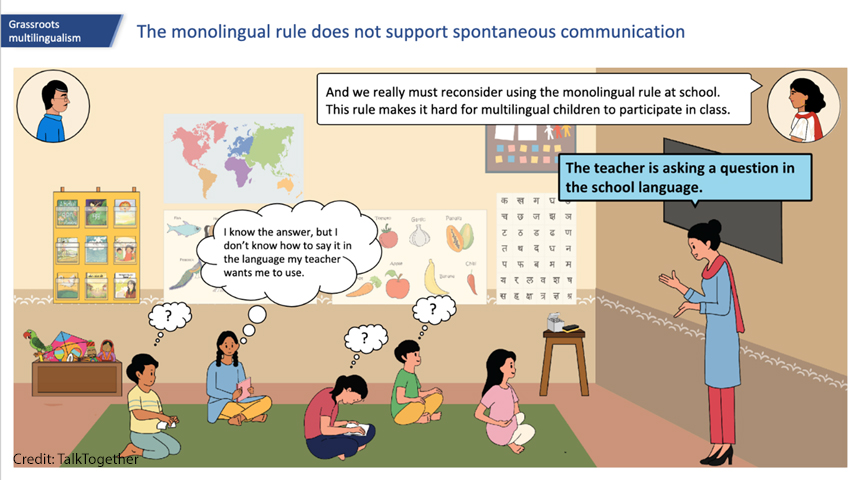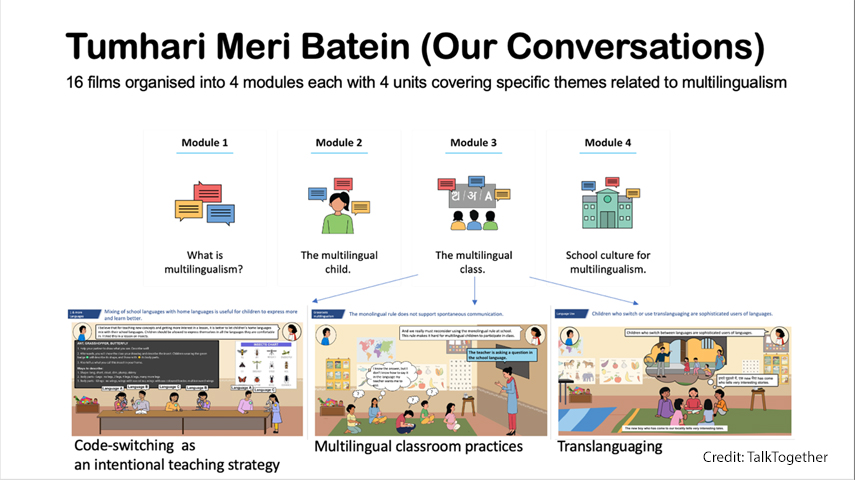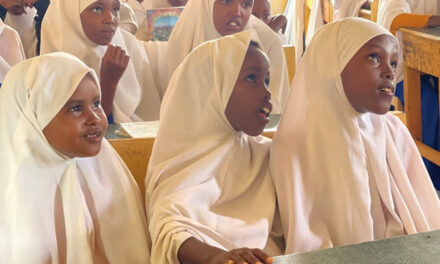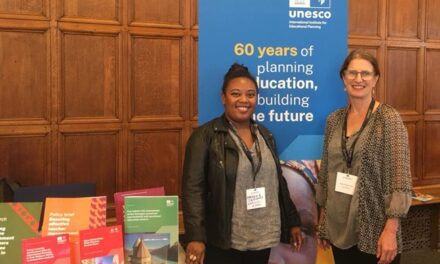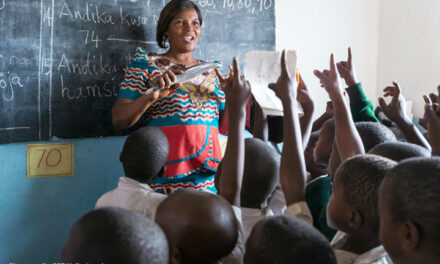This blog was written by Ernesto Roque Gutierrez (University of Oxford); Shashi Kant Singh (Room to Read); Hannah Simmons, Eliza Elizabeth George and Enxhi Sharxhi (University of Oxford); Gideon Arulmani (The Promise Foundation); Saktibrata Sen (Room to Read); and Sonali Nag (University of Oxford). It is based on their presentation from the September 2023 UKFIET conference.
Introduction and background
In the recent UKFIET 2023 Conference, amidst vibrant discussions on Rights, Equity, and Inclusion, our presentation delved into a pressing challenge many educators face: How do we support teachers asked to teach children who speak a home language that differs from the school language? We know access and participation in education is different for these children and yet professional development programmes that prepare teachers for multilingual classrooms are scarce.
This is predominantly true in the Global South, especially in Africa, Central and East Asia where multilingualism is the norm. India, a country renowned for its linguistic diversity, has only more recently witnessed a significant shift in its education language policy, with more emphasis being placed now on a model of multilingual education that values local, minority languages. This contained by the National Education Policy (NEP, 2020, p.13).
“It is well understood that young children learn and grasp nontrivial concepts more quickly in their home language/mother tongue (…). The medium of instruction until at least Grade 5, but preferably till Grade 8 and beyond, will be the home language/mother-tongue/local language (…) Teachers will be encouraged to use a bilingual approach, including bilingual teaching-learning materials, with those students whose home language may be different from the medium of instruction. All languages will be taught with high quality to all students; a language does not need to be the medium of instruction for it to be taught and learned well”.
This policy transformation in India exemplifies the evolving education landscape in other countries in the Global South. The renewed focus on multilingual education is both timely and essential. However, an important realisation is that policy does not necessarily translate to practice. The implementation of such policies is often shaped by deep-seated attitudes and beliefs surrounding language. As noted by Hornberger & Johnson (2007) and Asfaha (2013), classroom realities might differ significantly from policy directives.
Our theoretical approach
Derived from theorising by Nag (2023), current understandings in the disciplines of sociolinguistics, psycholinguistics and cognitive science, and evidence from intervention and school effectiveness research, the films share practical ideas and encourage reflection. For example, an important message is for teachers to give children the ‘wait time’ needed to formulate their thoughts – something that is particularly crucial for advancing multilingual language and literacy skills. The films also support teachers in extending what children say as a way of introducing new vocabulary and more complex narratives.
Teachers understand the importance of drawing upon children’s experiences and prior knowledge to make lessons meaningful and valuable to them. This, too, applies to their language. Mixing codes is an efficient use of what children bring to school, and the films challenge the conventional notion that mixing languages is a ‘lower form of language pedagogy’. A strict adherence to a monolingual rule in school does not support child learning. Children’s ability to switch between their languages is not a symptom of a deficiency but a sign of sophisticated use of languages.
Bridging the gap with films
Recognising this, our team at TalkTogether with our partners from Room to Read (India) embarked on a pioneering initiative: a 16-film series aimed at preschool and early grade teachers. The films are organised into four models with four units, each covering specific themes related to multilingualism.
But why films?
In an era where technology permeates every facet of our lives, films stand out as low-cost, self-paced resources with vast dissemination potential. They bridge the gap between traditional and modern teaching aids, making them an ideal medium for this initiative. This adaptability is most evident in the diverse ways films have been embraced across different states in India. In regions such as Chhattisgarh, Jharkhand, Madhya Pradesh, Telangana, and Uttar Pradesh, teachers are already discussing these films and sharing them via their pre-existing WhatsApp groups. Such initiatives reflect the organic and decentralised dissemination potential of film-based resources. One of these early adopters, a teacher from Jharkhand, comments on his experience with the films so far and the gap in professional development courses:
“Earlier we often used to teach children in Hindi only, we could not understand how difficult it is for children to understand Hindi, but after NEP – 2020, children should be taught their home language in schools. We could not understand how to start teaching children in their home language, during this time we did this multilingual course. Now I understand those points which are helpful to understand the children and help them.”
While these films are currently housed in structured platforms— at Chhattisgarh’s government learning management system, with prospects of being integrated into the Digital Infrastructure for Knowledge Sharing (DIKSHA) platform—they are not confined to them. The beauty of films lies in their ability to transcend formal boundaries, seamlessly flowing into less conventional channels, ensuring that their invaluable content reaches as many educators as possible.
A valid concern around the use of self-paced resources is whether their learnings can be translated into classroom practice. While the films are designed to contain key messages about multilingualism in school, how do we ensure these messages lead to action? One proposal we have developed is that of using complementary, in-person workshops. These sessions are not mere passive viewings; they’re structured engagements. Attendees watch the films collectively, delve deep into reflections, discuss the content, and most crucially, how to integrate these learnings into their pedagogical practices. They also receive feedback from their mentors and peers based on post-workshop classroom observations. In other words, we recognise the invaluable opportunity of embedding the films in the existing communities of practice and other professional development structures and mechanisms. These films not only serve as self-paced resources for individual educators but also have the power to stimulate group discussions, foster collective learning, and prompt shared reflection.
Conclusion
Every child, regardless of their linguistic roots, deserves a quality education—a mission that transcends mere pedagogy and speaks to broader societal values of rights, equity, and inclusion. Our richly illustrated films are a testament to this belief, aiming to empower teachers in supporting each child’s unique learning journey. While this film-based approach to reaching multi-disciplinary research evidence to teachers is a prominent pillar of the work of TalkTogether, our commitment extends far beyond. In our continuous exploration of the multifaceted world of multilingualism in the Global South, we are looking to actively craft and integrate solutions into the very fabric of existing educational systems.
References
Asfaha, Yonas Mesfun. “From Policy to Practice: Multiple Language and Script Education in Eritrea.” Bilingual Education and Language Policy in the Global South. (2013). 49-65.
Hornberger, Nancy H., and Johnson, David Cassels. “Slicing the Onion Ethnographically: Layers and Spaces in Multilingual Language Education Policy and Practice“. TESOL Quarterly 41.3 (2007): 509-32.
Nag, Sonali. “Teaching and learning: what matters for intervention”. Oxford Review of Education. 49(1) (2023): 1-9, doi: 10.1080/03054985.2023.2161197
NEP 2020. “National Education Policy”. Ministry of Human Resource Development, Government of India. (2020).

